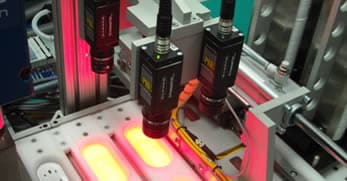Machine vision is an integrated, imaging-based automated inspection and analysis technology used in production lines or related manufacturing activities. A machine vision system consists of several key components that interact to perform automated tasks.
What is Machine Vision?

Machine vision is utilized in industrial automation environments and is an essential, key technology in production lines. Its benefits are many. This type of technology:
- Is capable of real-time inspection
- Ensures quality control
- Increases productivity
- Lowers production costs
- Reduces waste
- Manages inventory
- Improves safety
The computerized, robotic guidance system utilizes sensors, i.e., a camera or multiple cameras, to inspect and analyze components, parts, or objects in conveyance. The imaging data acquired by the sensors is applied for process control of the items using programmed processing hardware and software algorithms. The integrated system sensor captures images for inspection to be processed by a vision appliance that renders and communicates the results to system operators for appropriate action.
During a typical manufacturing activity on a production line, once an operation on a component has been completed, machine vision sensors capture and process images of the operation for visual inspection. The camera can inspect the accuracy, position, shape, size, colors, or barcodes to ensure the item is processed correctly.
Important Benefits in Manufacturing
Much like the benefits of automation, machine vision technologies help companies improve manufacturing systems’ efficiency, quality, and operation.
Eliminates human error
The automated imaging system can automate the inspection of mundane or complex tasks. It is far more efficient than humans in performing such tasks that involve a repetitive inspection. Human inspectors cannot maintain the pace, speed, objectivity, and accuracy that inspections by machine vision technology can. Hundreds and even thousands of parts per minute can be inspected by machine vision with dependable and consistent results that far exceeds the possibilities of human inspectors.
Improves product quality and reduces waste
Machine vision systems also improve product quality. Manufacturers no longer have to rely on sample testing of products. The technology enables manufacturers to achieve 100% quality checks done by the camera imaging sensors. Every component, part, or item in every batch or production run can be reliably checked for quality control and reveal flaws during the manufacturing process without interruption. Revealing flaws in real-time reduces waste in real-time and assures 100% quality control.
Lowers production costs
Implementing a machine vision inspection system during the early stages of production immediately removes any faulty or defective parts from the assembly process. Because flawed parts are removed immediately, they cannot be introduced into further stages of production where, ultimately, they would end up producing a defective product. Reducing defective parts at the source, then, has the subsequent effect of increasing production yield. In addition to identifying defective parts, the technology helps determine where those problems occur to take corrective action immediately.
Increases safety
This technology also introduces additional safety into manufacturing environments. Fewer people can be injured in a manufacturing process with reduced human involvement in a manufacturing process. In clean room production environments, it prevents human contamination. In hazardous environments, it protects workers from exposure to dangerous conditions.
Examples of Machine Vision Technology in Practice
Machine vision technology has more to offer than quality control; it helps manufacturers and producers organize and manage production with increased efficiency daily.
Agriculture – For example, in farming, this technology aids in harvesting automation and can be used to monitor crops and detect diseases or pest invasions. Robotic harvesting machines utilize machine vision to locate ripe grapes on the vine to be picked without destroying any.
Inventory Control – Because this technology can read barcodes and labels on components and products, it has become an essential tool in inventory control. In managing processes, the technology ensures that the correct components are added to products and accounted for in real time while moving down an assembly line. The technology is also used for bin-picking done in warehouses by robots.
Tracking and Traceability – Where compliance and regulatory issues are in place, machine vision enables product tracking and traceability. Heavily regulated industries like the pharmaceutical industry can use machine vision to track ingredients and serial numbers for products and even monitor expiration dates. For medical devices like surgical tools manufactured with advanced automated assembly techniques, each part of every component can be 100% inspected.
Quality Control – Machine vision can also be used to measure and calibrate parts and products. For example, an ultrasonic automated welding system designed for increased speed and accuracy in welding plastic joints can have all 28 weld joints per part measured with precision and 100% inspected with machine vision technology.
Machine vision is an advanced technology with many beneficial applications. When manufacturers introduce the technology into their systems, it increases system productivity and production. The technology has a unique ability to enhance quality control while simultaneously reducing production costs, increasing inventory control and management, improving safety, ensuring compliance, tracking parts, and increasing efficiency.
